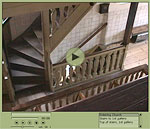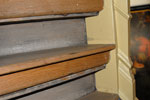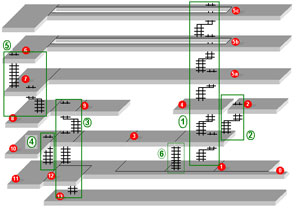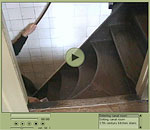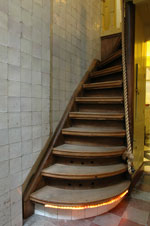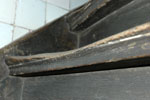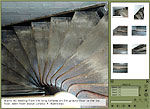Our Lord in the Attic: A Case Study
Stairs
The routing in 3-D.
![]() Floor plans (PDF, 2.1MB)
Floor plans (PDF, 2.1MB)
![]() 'Description of area' database (PDF, 664KB)
'Description of area' database (PDF, 664KB)
![]() Database area reference key (XLS, 571KB)
Database area reference key (XLS, 571KB)
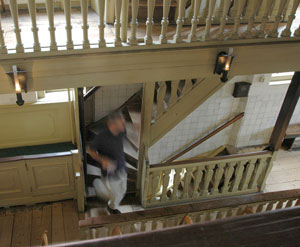 The visitors walk from room to room via narrow hallways, corridors and steep stairs. The stairs are a unique feature in this building and considered of great importance. The structure of most stairs is original, although many stairs have had their top steps covered with new wood, most likely in the 1970’s. There are however still two authentic 17th century stairs: the stairs leading to the canal room and the chaplain's room and the stairs leading from the ground to the first floor in the main house.
The visitors walk from room to room via narrow hallways, corridors and steep stairs. The stairs are a unique feature in this building and considered of great importance. The structure of most stairs is original, although many stairs have had their top steps covered with new wood, most likely in the 1970’s. There are however still two authentic 17th century stairs: the stairs leading to the canal room and the chaplain's room and the stairs leading from the ground to the first floor in the main house.
Walking through this building, climbing and descending the steep stairs and hearing the creaking of the wood is considered essential to the visitors' experience.
Description
In the museum there are several staircases - most of them in use by the visitors:
The staircase in the front of the house (1) leads all the way up to the church and extends to the two galleries. This staircase is used for the first part of the tour. The staircases at the back of the property are then used to descend (5 and 3). Staircase 5 is an 18th century addition to allow a quick evacuation of the church goers.
In the schematic 3-D overview(click to enlarge), the stairs are indicated with green numbers:
- stairs leading from the antechamber to the sael and into church
- a small staircase leading from the hall next to the sael into the canal room and chaplain's room
- staircase in the first house at the back, from the basement to the confessional
- stairs between Leeuwenberg room and 17th century kitchen
- a staircase between the Lady chapel and the room behind the altar on the level of the church's 1st gallery
- stairs leading from the long hallway on the ground floor to the 1st floor
Stairs 2 and 6 date back to the 17th century and are considered authentic. The other stairs have an original structure, but their top steps were covered with new wood, most likely in the 1970’s.
Small white glazed tiles were used for skirting the walls of many of the staircases. These typical tiles were produced from 1600-1900.
Videos of visitors using the stairs
Original stairs (4) to 17th century kitchen - steps are covered.
17th Century stairs
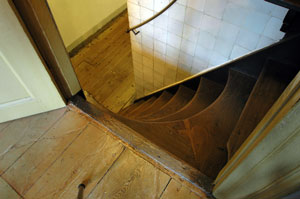 17th Century oak stairs (2) run from the 1st floor to the canal room and onto the chaplain\x92s room. The current situation was created in 1663, although it is believed that the steps leading up to the chaplain\x92s room must be older. Traditionally, these stairs were not used by churchgoers, only by the family and their staff. Since the house became a museum, these stairs are used to enter the canal room and are used by visitors in both directions. It is unclear if the steps to the chaplains\x92 room were ever part of the museum routing in the past. They have not been used for some time now, as this room is closed off for visitation.
The steps lost 6-10 mm of the original 62-64 mm by abrasion. The steps leading into the chaplains\x92s room were not abraded to the same extent; only 3 mm of oak was worn off.
17th Century oak stairs (2) run from the 1st floor to the canal room and onto the chaplain\x92s room. The current situation was created in 1663, although it is believed that the steps leading up to the chaplain\x92s room must be older. Traditionally, these stairs were not used by churchgoers, only by the family and their staff. Since the house became a museum, these stairs are used to enter the canal room and are used by visitors in both directions. It is unclear if the steps to the chaplains\x92 room were ever part of the museum routing in the past. They have not been used for some time now, as this room is closed off for visitation.
The steps lost 6-10 mm of the original 62-64 mm by abrasion. The steps leading into the chaplains\x92s room were not abraded to the same extent; only 3 mm of oak was worn off.
(4) The original 17th century stairs (1663) in the house at Heintje Hoekssteeg that run from ground floor to 1st floor and lead the visitors form the Leeuwenberg room down to the 17th century kitchen, were covered with new protective steps in the 1970’s. These new steps have been integrated in the stairs.
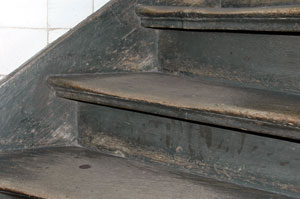 (6) The oak stairs leading in a curve from the hall on the ground floor towards the 1st floor are authentic 17th century stairs. These were closed to the public and taken out of the normal museum routing in 2002. These stairs have since only been in use during weddings, and only by the bride. The steps of this stair have lost about 11-13 mm of their original thickness (31 mm). This wear is especially noticeable in the wider part of the triangular shaped steps that make the curve.
(6) The oak stairs leading in a curve from the hall on the ground floor towards the 1st floor are authentic 17th century stairs. These were closed to the public and taken out of the normal museum routing in 2002. These stairs have since only been in use during weddings, and only by the bride. The steps of this stair have lost about 11-13 mm of their original thickness (31 mm). This wear is especially noticeable in the wider part of the triangular shaped steps that make the curve.
Wear and tear on the original 17th century stairs (6).
Launch image viewer of the stairs
![]() Visitation records (XLS, 49KB)
Visitation records (XLS, 49KB)
Condition of the stairs
All stairs show sign of wear and tear (recorded in a condition assessment in 2006), not only in the abrasion of the steps, but also in dents to the upright part of the next step, caused by the shoes kicking into it. This is most obvious in areas where steps are narrow. As most stairs have a slight bend or curve, the abrasion is worse in these areas. To better understand the wear and tear of the stairs and floors in the building, it is important to get a sense of the number of people that visited the church and later the museum.
 Most stairs are difficult to climb and descend and the provided railing does not give enough safety or comfort for visitors. Observing visitor behavior on the stairs, there is a strong need to hold on to other surfaces, such as balustrades, posts or walls. It is in these areas that paint is worn away; exposing the wood underneath and grime from hands is building up.
Most stairs are difficult to climb and descend and the provided railing does not give enough safety or comfort for visitors. Observing visitor behavior on the stairs, there is a strong need to hold on to other surfaces, such as balustrades, posts or walls. It is in these areas that paint is worn away; exposing the wood underneath and grime from hands is building up.
The 17th century stairs lost on average 10 mm in the past 100 years with approximately 1.2 million visitors, equaling 8x10-6mm per visitor. The replaced steps on the stairs show an average loss of 0.4 mm loss in 20 years caused by 800,000 visitors, 5 x 10-7 mm abrasion per visitor (0.4/800,000 mm). This century may result in 6 million visitors, which would result in 3 mm loss of the same steps. This equals 15% of a step of 20 mm thick.

